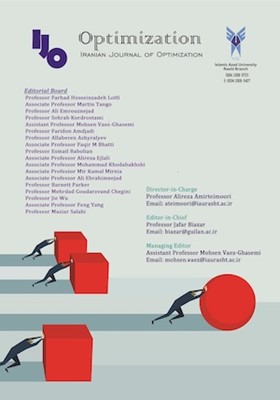Using Theory of Constraints in Production Management and Scheduling (A Case Study)
الموضوعات :
Ahmad Hooshmand
1
,
Ali Reza Mehrazeen
2
![]() ,
Ali Reza Davoody
3
,
Mohamad Reza Shorvarzi
4
,
Ali Reza Davoody
3
,
Mohamad Reza Shorvarzi
4
1 - Department of Accounting, torbat heidareh Branch, Islamic Azad University, torbat heidarehr, Iran
2 - Department of Accounting, Neyshabur Branch, Islamic Azad University, Neyshabur, Iran
3 - Department of Mathematics, Neyshabur Branch, Islamic Azad University, Neyshabur, Iran
4 - Department of Accounting, Neyshabur Branch, Islamic Azad University, Neyshabur, Iran
الکلمات المفتاحية: Sensitivity analysis, Theory of Constraints, Bottleneck, production scheduling,
ملخص المقالة :
In manufacturing institutes the only access way to maximum profit is identifying the production mix of the products based on the limitations such as policies and politics, demand and production processes. This study identifies the constraints of a tile-manufacturing company including constraints in its production and demand line using LINGO software version 15, and identifying production bottleneck, i.e. furnace, production scheduling was provided and sensitivity analysis was con-ducted on the variables and right hand items. Positive shadow price of furnace shows efficiency of every unit on throughput. Also, in demand constraint, negative shadow price of product 16 shows decreasing effect of increase of every unit on throughput. Allowable increase and decrease of right hand items show allowable increase in furnace section and limitlessness of allowable decrease of product 16. Changes in this range causes that the current basis remains optimal changes in which causes changes in the optimal value of the target function regarding shadow prices.
Amitava, R.,Sarkar, B., & Sanyal, K. (2008). Research on improved theory of constraints, International Journal of Accounting and Information Management, 16(2) 155-163.
Badri, S., Ghazanfari, M., & Makui, A. (2014). An integrated model for product mix problem and scheduling considering overlapped operations. Decision Science Letters, 3(4), 523-534.
Badri, S.A., & Aryanezhad, M.B. (2011). A Mathematical method for managing the system constraint, IJE 24(1), 37-47.
Chaharsooghi, S., & Jafari, N. (2007). A simulated annealing approach for product mix decisions, 14(3), 230-235.
Detmer,W.(2015). Thinking process of TOC of Goldratt: A systemic approach to the continuous improvement, translated by Razmi, J., and Nematipour, M., Jahaddaneshgahi Publication, 1st Ed.
Fredendall, L. D., & Lea, B. R. (1997). Improving the product mix heuristic in the theory of constraints. International journal of production research, 35(6), 1535-1544.
Godferey, C., Onwubolu, G.C., & Muting, M. (2001).Optimizing the multiple constrained resources product mix problem using genetic algorithms, International Journal of Product Research, 39(9), 1897-1910.
Godfrey, C. (2001).Taboo search- based algorithm for the TOC product mix decision. International Journal of Production Research, 39(10), 2065-2076.
Golabchi, M., &Faraji, A.(2013). Modern theories in project management, 1st Ed, Tehran University Publication (in Persian).
Golmohammadi, D., &Mansouri,S.A.,(2015). Complexity and workload consideration in product mix decisions under the theory of constraints, Naval Research Logistics, 62, 357-369.
Gundogar, E., Sari, M., & Kokcam, A. H. (2016). Dynamic bottleneck elimination in mattress manufacturing line using theory of constraints. SpringerPlus, 5(1), 1276.
Hadidi, L. A., & Moawad, O. A. (2017). The product-mix problem for multiple production lines in sequenced stages: a case study in the steel industry. The International Journal of Advanced Manufacturing Technology, 88(5-8), 1495-1504.
Mishra, N., Tiwari, M. K., Shankar, R., & Chan, F. T. (2005). Hybrid tabu-simulated annealing based approach to solve multi-constraint product mix decision problem. Expert systems with applications, 29(2), 446-454.
Namazi, M. (2015). Strategic management accounting from theory to practice.Vol.2, SAMT Publication (in Persian).
Pacheco, D. A. D. J., Pergher, I., Antunes Junior, J. A. V., & Roehe Vaccaro, G. L. (2018). Exploring the integration between Lean and the Theory of Constraints in Operations Management. International Journal of Lean Six Sigma.
Panizzolo, R. (2016). Theory of constraints (TOC) production and manufacturing performance. International Journal of Industrial Engineering and Management, 7(1), 15-23.
Plenert, G. (1993). Optimizing theory of constraints when multiple constrained resources exist. European Journal of Operational Research, 70(1), 126-133.
Rafiei,H., &Torabi, S.A.(2012).Representing an algorithm for producing elementary answers for the innovative algorithms of product mix problem based on TOC, Expert Journal of Industrial Management, 46(2), 195-204.
RahnamayRoodposhti, F. (2008). Strategic management accounting based on value-creating cost management, 1st Ed, Islamic Azad University Publication, Science Research Branch (in Persian).
Rashidikomijan,A.B., Aryanezad,M.,&Makui,A.(2009). A new heuristic approach to solve product mix problems in a multi-bottleneck system, Journal of Industrial Engineering International, 5(9), 46-57.
Trojanowska, J., & Dostatni, E. (2017). Application of the theory of constraints for project management. Management and production engineering review, 8(3), 87-95.


